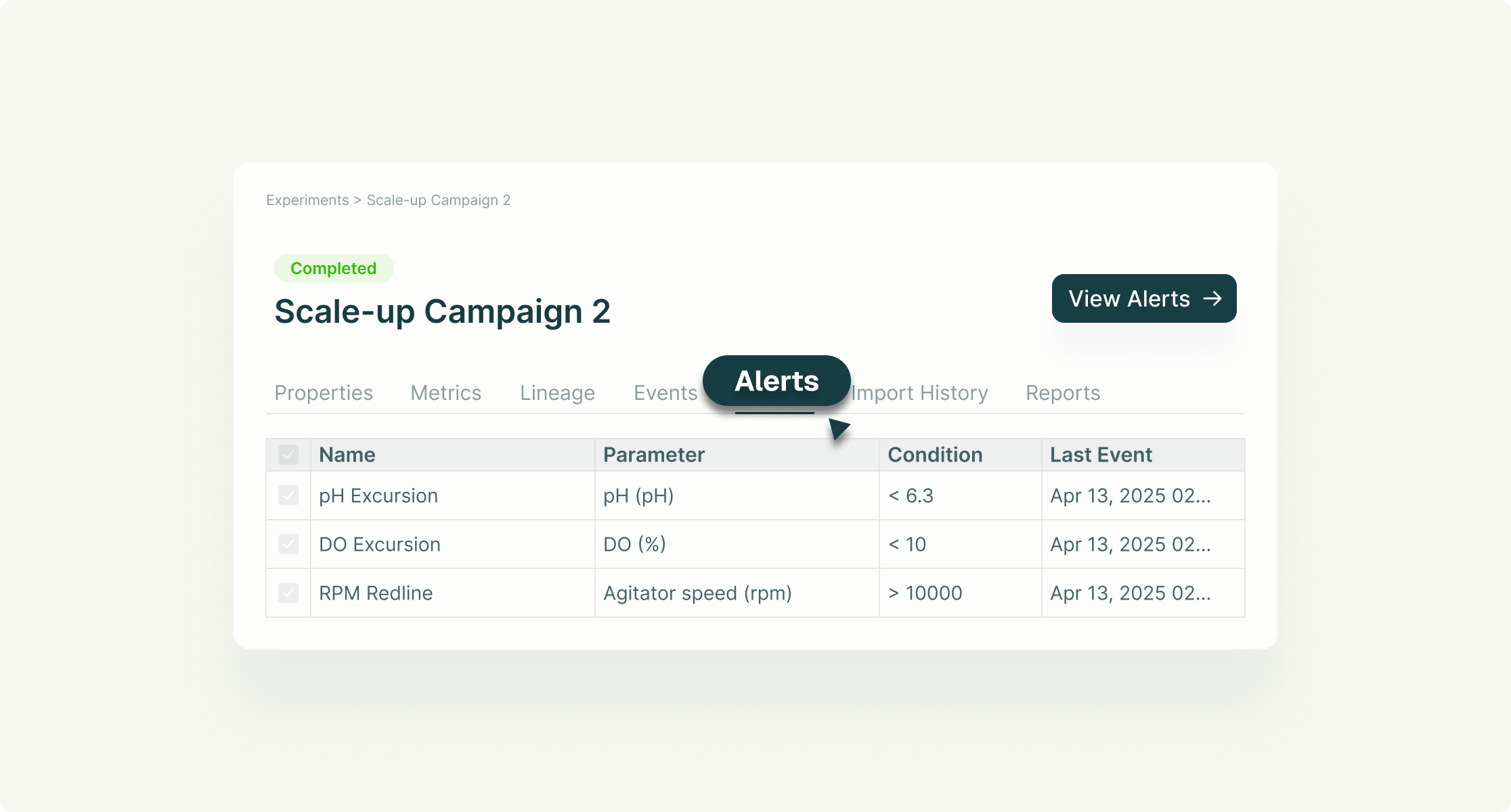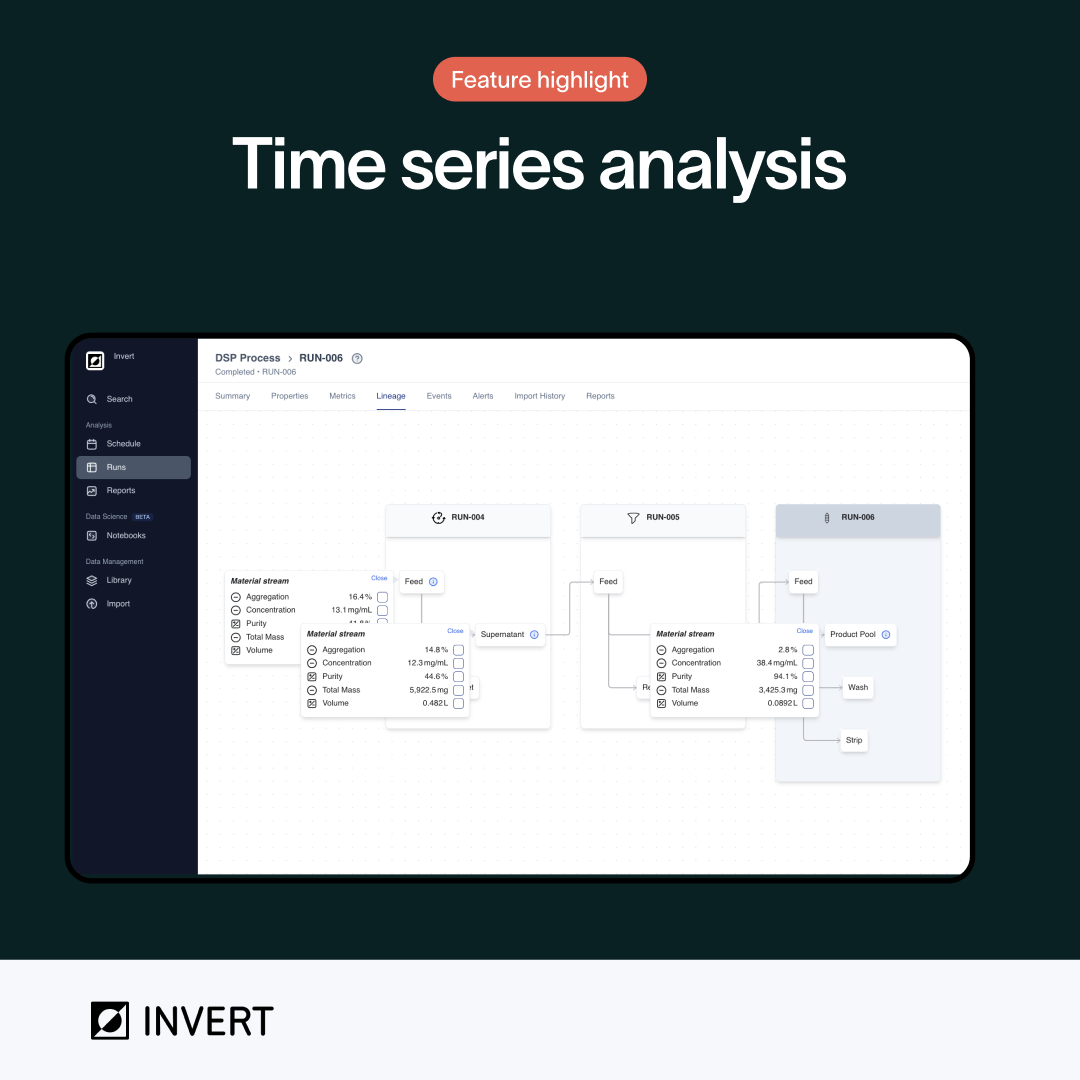Invert Launches Alerts: Turning Real Time Data Into Immediate Action

Bioprocessing teams generate mountains of valuable live data. But too often, that data is only useful in hindsight, analyzed after a costly run has already failed. With the launch of Invert Alerts, we are changing that.
Invert Alerts transform real time bioprocess data into immediate, actionable notifications so scientists can act in the moment, protect their runs, and focus on advancing processes instead of manually monitoring them.
From Watching to Acting: What Invert Alerts Does
Until now, Invert customers have been able to stream live data directly from bioreactors and other lab equipment into a unified platform. That visibility is powerful, but it still required constant manual oversight to catch excursions before they became catastrophic.
Invert Alerts closes that gap by continuously scanning live data against defined thresholds and immediately notifying the right people when conditions drift outside of range. Instead of relying on scientists to spot issues in dashboards, the system transforms real time data into real time action. Alerts are logged in the Invert interface with full visibility into status, timing, and resolution, ensuring not only quick interventions but also a permanent, auditable record of what happened.

Why We Built Alerts: Customers Asked, and the Stakes Are High
The need for Alerts came directly from the lab. Customers and prospects repeatedly shared the same frustration: equipment alarms were difficult to configure, siloed in individual systems, and easy to miss. Teams were losing valuable material overnight because no one knew when excursions occurred, and the consequences were devastating.
A single missed excursion can mean hundreds of thousands of dollars in wasted material, weeks of delay while experiments are restarted, and in clinical settings, lost doses that never make it to patients. For scientists already stretched thin, the burden of constant vigilance added mental stress on top of the financial and operational risks. Alerts were built to solve this head on by putting real time control back in the hands of bioprocess teams and ensuring no run is lost to silence.
The Impact: Protecting Runs, Protecting Progress
With Alerts, the difference between failure and success comes down to minutes, not hours. Consider a lab scale experiment where a nutrient feed tube clogs and pH levels rapidly dip. Without intervention, the run is doomed, but with an instant alert, the team has a critical 10 to 40 minute window to step in and correct the issue. At pilot scale, a sudden spike in dissolved oxygen can compromise cell viability. A timely email or text notification allows a scientist to act before the damage is irreversible. And in clinical production, where every dose counts, Alerts ensure that any temperature excursion is flagged immediately, protecting both timelines and patients who depend on those therapies.
In each of these scenarios, Alerts are not just about convenience, they are a safeguard for innovation. They prevent costly failures, protect valuable material, and reduce the mental load of manual monitoring, giving scientists confidence that their processes are always under control.
How to Use It: Simple, Configurable, Scalable
Getting started with Invert Alerts is straightforward:
- Open the Alerts tab under the Runs section in the Invert UI.
- Configure custom rules around your critical process parameters.
- Apply reusable alerts across multiple runs and experiments.
- Monitor and manage alerts with full traceability, including resolution history.
Whether you need to track a single parameter like pH or build more complex conditions, Invert Alerts gives you the flexibility to start simple and the power to scale as your processes evolve.

See Invert Alerts in Action
Real time action from your data means fewer failures, less wasted material, and more confidence in your processes.
Request a demo today to see how Invert Alerts can protect your runs and free your team to focus on advancing science.
.png)
Engineer Blog Series: From Bioprocess to Software with Anthony Quach
Welcome to Invert’s Engineer Blog Series — a behind-the-scenes look at the product and how it’s built.In this post, software engineer Anthony Quach shares how his career in bioprocess development led him into software, and how that experience shapes the engineering decisions behind Invert.
Read More ↗
Connecting Shake Flask to Final Product with Lineage Views in Invert
Invert’s lineage view connects products across every unit operation and material transfer throughout the entire process. It acts as a family tree for your product, tracing its origins back through purification, fermentation, and inoculation. Instead of manually tracking down the source of each data point, lineages automatically show material streams as they pass through each step.
Read More ↗
Engineer Blog Series: Security & Compliance with Tiffany Huang
Welcome to Invert's Engineering Blog Series, a behind-the-scenes look into the product and how it's built. For our third post, senior software engineer Tiffany Huang speaks about how trust and security is a foundational principle at Invert, and how we ensure that data is kept secure, private, and compliant with industry regulations.
Read More ↗